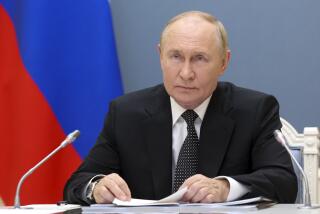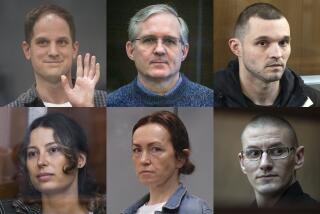COLUMN ONE : Crime in the Era of Glasnost : The Soviet public is reeling under an unprecedented surge in violence. Experts blame it on turmoil in a time of wrenching reform.
MOSCOW — The dingy yellow bedroom wall in the two-room apartment on Kuntzevsky Street was stained with blood, as was a chair in the corner and an Oriental rug on the floor. An opened pack of Stolichni cigarettes and a plate of half-eaten, slowly rotting grapes lay on the nightstand next to a popular detective novel.
In the adjoining room, the contents of drawers and shelves--family photographs, fashion magazines, West European nail polish--remained where they had been scattered.
The sense of recent panic mixed with violence was tangible, even though it had been nearly a month since the morning Elena F. Goryachev unlocked her double-chained door and welcomed in two men, one an acquaintance and the other a stranger, who were to be her killers.
Thus did the 27-year-old Goryachev, recently separated from her husband, unemployed and living alone, became another grim statistic in a country that, officials now acknowledge, is suffering from the fastest growing rate of violent crime in the world.
The Soviet Union’s soaring numbers of murders, rapes and armed robberies, once blamed on the twin Western “diseases” of capitalism and worker exploitation, today appear to be a frightening side-effect of the tremendous social upheaval brought on by perestroika, President Mikhail S. Gorbachev’s reform program.
The unprecedented public questioning of long-shared societal values--under glasnost, or openness--has left many, particularly the young, without a moral anchor, according to sociologists, criminologists and law enforcement officials. Along with the country’s persistently worsening shortages of basic goods, it has fueled a rising crime rate, they say.
Experts also blame a growing lack of respect for authority, reflected in the inability of police to deter would-be criminals, and a public perception that under Gorbachev crimes are not as harshly punished as they once were.
In the first nine months of 1989, violent crime increased across the country by 41% over a year ago, according to government statistics. Daily reports of often random violence have shocked people in this country that Soviet officials once claimed was virtually crime-free.
The figures are even more alarming for Moscow, where violent crime jumped by 81% in the same period. An average of 20 violent crimes are committed every day in the capital, where 9 million people live, Moscow district prosecutor Nikolai I. Kapunus said in an interview.
There are still more murders in the United States, Soviet officials say, but the gap is narrowing--5.9 murders per 100,000 Soviet citizens compared to 8.9 murders per 100,000 Americans.
“In addition, the murders in our country are becoming characteristically more sadistic, more aggressive and more random,” Kapunus said. “For the first time on record, in nearly half of our murder cases the victim did not know his or her killer.”
The Supreme Soviet, the country’s Parliament, has called for emergency measures to fight crime, and special commissions were set up last month in each of the Soviet Union’s 15 republics but Gorbachev himself has warned: “Crime is still on the rise.”
The problem of crime was previously dismissed here as relatively minor--when it was discussed at all. A decree issued by the dictator Josef Stalin in 1933 barred disclosure of crime data, apparently on the basis that it could damage the country’s image abroad and encourage further crime.
One case in the 1960s in Moscow, however, became famous simply because the police, desperate to capture a serial child murderer, posted a drawing of his face throughout the city.
But such publicity was rare. Generally, officials stated and the media reported that the crime rate was steadily falling and that most murders were the result of family disputes.
Not so today. In the last 12 months, alarmed officials have been routinely reporting to an increasingly shocked and uneasy public brutal crimes with random victims.
Among those currently in city prosecutor Kapunus’ file:
-- The bodies of a 9-year-old girl and her mother, who had been visiting Moscow from a nearby village, were found along the Moscow River late last year. The girl had been raped, and both were shot to death. Police believe that the murderer, who remains at large, offered the two a lift in his car--a common act in Moscow where taxis are often difficult to find--drove them to a secluded area and then killed them.
-- Five teen-age girls were raped by a 21-year-old man in one Moscow neighborhood in less than a week in September before he was arrested by police. He is now in custody, and officials are checking to see if he can be linked to other rapes in the city.
-- Goryachev was murdered by two men who were captured almost immediately after her death when a passing policeman saw them emerging from the apartment building carrying a video cassette recorder and other stolen items.
Not only did the men slash her to death before robbing her, but one also chopped off her left ear, put it in a plastic bag and carried it away in his pocket. Police believe he did so because he intended to use it both to scare future victims and to prove his toughness to his friends.
The growing incidence of crime has left many Soviet people feeling vulnerable.
“I can’t believe I live in a building where this happened, and of course it has made me more frightened,” said Nadia, a well-dressed woman who stopped to talk to visitors outside the apartment house where Goryachev lived. “I don’t walk alone at night any more, and I’ve told my 12-year-old daughter to never, never open the door to anyone.”
Soviet sociologists generally agree that the main cause of the country’s soaring crime rate is the steadily worsening economic situation. Shortages in basics from food to clothing are far more common and widespread than they were in the era of former Communist Party leader Leonid I. Brezhnev, and the frustration this breeds can erupt into violence.
“When you have to stand in line for hours day after day, and even then you cannot buy what you want, it doesn’t make you like the people around you,” Kapunus said. “There is a kind of aggression toward society that builds up, and then explodes into crime.”
Alcohol, he noted, is the one thing that again is widely available after a three-year reduction in sales, and in about 70% of violent crimes, alcohol abuse was a contributing factor.
In addition, Soviet officials attribute the rising crime rate to changing social standards under Gorbachev. As part of his effort to reform the country’s political and economic system, Gorbachev has encouraged citizens to stop depending on the state and blindly supporting it and instead to question all authority and rely on personal initiative.
Without the firm moral base that the Communist Party sought to provide in the past, many Soviet youth have become alienated and turned to alcohol, drugs and gang crime, according to Soviet sociologists.
“World practice shows that this situation (the rise in crime) is typical of any society living through a transition period,” Interior Minister Vadim Bakatin said in an interview with the official Tass news agency. “But the way out is to accelerate perestroika and the improvement of society, beginning with the economy.”
Once it started, the crime wave spiraled because the country was caught off-guard, Kapunus and other law enforcement officials say. There were not enough police officers, and they lacked sufficient equipment to patrol adequately the increasingly mean streets.
Consequently, even the police themselves have become victims.
In the 18 months ending June 30, 361 Soviet police officers were killed in the line of duty, according to figures from the Soviet Ministry of Internal Affairs. In the 16 1/2 months ending May 16, 1989, according to FBI reports, 106 police officers were killed in the United States.
Capt. Yuri P. Bikov of Moscow’s Volgogradsky District has paid particular attention to the Soviet numbers ever since two of his friends, a lieutenant and a sergeant on duty at a police checkpoint, were killed four years ago by criminals who hoped to take their guns and use them to carry out a bank robbery.
“Four years ago, this was an exception, big news. But just four days ago a policeman was shot to death in central Moscow, and nobody even pays that much attention. We are already used to it,” Bikov, 33, said as he paused with a visitor in front of a painting of the two dead men that hangs in the Volgogradsky police station.
Under Gorbachev, new emphasis is being given to the rights of the accused but, Bikov complained, the needs of the police force have been overlooked.
“The criminals are not afraid of us any more,” he said, calling specifically for amending a regulation requiring that an officer first fire in the air before aiming at a suspect.
He also said that pay for police, which starts at about 200 rubles a month, or $320 at the official exchange rate, should be boosted. Average pay for a Soviet worker is about 236 rubles a month.
“Because the pay is low and the work dangerous, young people are not entering our ranks any more,” he said. “We also lack proper equipment--everything from cars to radios. Until these things change, you can’t expect to see any significant drop in crime.”
Natalie Pavlov, a Moscow pianist, agrees that the nation’s police departments need to be revamped, but she does not think that is enough to prevent crime.
Pavlov’s 20-year-old daughter Katchia was murdered last December on the street outside their apartment. Two males, one 27 and the other 16, approached her and asked her to talk to them. When she refused, one pulled a gun.
“Please help me. They are trying to kill me,” Katchia screamed before a fatal shot was fired into her chest.
Pavlov, who has two other daughters, suffered a nervous breakdown and spent two months in a hospital.
“I once considered myself the happiest mother in the world,” Pavlov said, crying softly as she gazed at photographs of Katchia displayed in a bookcase in her central Moscow home. “I will recover one day, I guess, but I will never be the same person.”
Though she is now back at work and trying to resume a normal life, she is still not sure she is psychologically able to attend the trial currently under way of the two accused of killing her daughter. Although the teen-ager pulled the trigger, she feels certain he will get off lightly.
Soviet judicial law bans sentencing a criminal to life imprisonment; 15 years is the maximum possible prison term.
The Soviet Union does have the death penalty. The number of criminals sentenced to death is still secret, but an official at the Interior Ministry said that it is decreasing, even for convicted murderers, because of a changing philosophy in favor of “humanizing” the country’s criminal code.
Judges, in fact, are being encouraged to make greater use of probation and parole, particularly in the case of minors.
The effort at “humanization” led to the release of about 620,000 prisoners in 1987 and 1988. Today only about 30% of all convicted criminals are sent to jail.
But Pavlov, the mother of the murdered Katchia, believes the policy is backfiring and sending troubled delinquents back on the streets to commit more serious crimes.
“What we need is tougher punishment for criminals,” she said. “Maybe that will do something to stop the evilness in society today.”
“If we can’t stop the evilness, none of us will be safe. And without personal security, whatever we try to do to reform society will be pointless.”
BACKGROUND
Moscow, with a population of 9 million, has an average of 20 violent crimes every day. By comparison, Los Angeles, with only about 3.36 million people, has an average of 207 such crimes. But the figures for Moscow, covering the first 9 months of this year, are particularly alarming because they represent an 81% jump over the same period last year.
More to Read
Sign up for Essential California
The most important California stories and recommendations in your inbox every morning.
You may occasionally receive promotional content from the Los Angeles Times.










